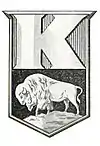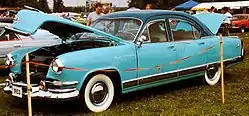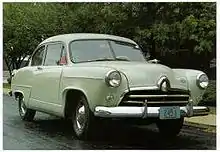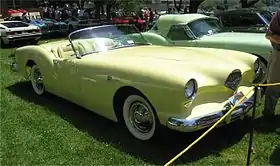Kaiser Motors
Kaiser Motors (formerly Kaiser-Frazer) Corporation made automobiles at Willow Run, Michigan, United States, from 1945 to 1953. In 1953, Kaiser merged with Willys-Overland to form Willys Motors Incorporated, moving its production operations to the Willys plant at Toledo, Ohio. The company changed its name to Kaiser Jeep Corporation in 1963.
 | |
| Industry | Automobiles |
|---|---|
| Fate | Merged with Willys-Overland Motors and re-named it Willys Motors; renamed it again as Kaiser Jeep Corporation |
| Predecessor | Kaiser-Frazer Corporation |
| Successor | Kaiser Jeep |
| Founded | July 14, 1945 |
| Founder | Henry J. Kaiser |
| Defunct | August 13, 1953 |
| Headquarters | , |
Key people | Henry J. Kaiser, Edgar Kaiser |
Production output | 1945–1953 |
| Owner | Henry J. Kaiser |


.jpg.webp)

History
The Kaiser-Frazer Corporation was established in August 1945 as a joint venture between the Henry J. Kaiser Company and Graham-Paige Motors Corporation. Both Henry J. Kaiser, a California-based industrialist and Joseph W. Frazer, CEO of Graham-Paige, wanted to get into the automobile business and pooled their resources and talents to do so.[1] Less than a year after Kaiser-Frazer's formation, the first Kaiser and Frazer branded automobiles were being produced at the Willow Run, Michigan, headquarters for both Kaiser-Frazer and Graham-Paige. By the end of 1946, over 11,000 cars (total Kaiser and Frazer) went out to dealers and distributors; many of them sold to retail owners.[2] During the summer of 1948, the 300,000th car came off the production line.[3]
In 1950, Kaiser-Frazer began production of a new compact car, the Henry J[4] and ended production of the Frazer automobile;[5] both makes were 1951 model year automobiles. In 1952 and 1953, Kaiser-Frazer provided Sears, Roebuck and Company with Allstate-branded automobiles that retailer sold through selected Sears Auto Centers. The cars, based on the Henry J models that Kaiser-Frazer dealers were selling, were in the Sears catalog, but the car could not be purchased by mail order.[6]
At the 1953 New York Auto Show, Kaiser-Frazer announced it would produce a fiberglass bodied sports car, called the Kaiser-Darrin-Frazer 161 (the car had a 161 cubic inch six-cylinder engine and was designed by stylist Howard "Dutch" Darrin, who also did the 1947–48 Kaiser & Frazer as well as the 1951 Kaiser automobiles).[7] This vehicle went into production during January 1954 and was sold as the Kaiser Darrin.[8] Production of the Allstate ended during 1953, the last Henry J automobiles were built in late 1953 as 1954 model year cars. The sports car was in production only during the 1954 model year and the last Kaisers were produced in America during the 1955 model year.[9] Close to 760,000 cars were produced, all makes and models, between May 1946 and September 1955.[10]
While sales were initially strong because of a car-starved public, the company did not have the resources to survive long-term competition with the "Big Three" automakers: GM, Ford, and Chrysler. The original Kaiser-Frazer design was distinctive and fresh but the company was unable to maintain the price point it needed for long-term success. However, the company's problems started as early as 1948. That year, Joseph Frazer resigned as president of Kaiser-Frazer, but stayed in the position as a "lame duck" until April 1949 when Henry J. Kaiser's oldest son, Edgar, took Frazer's place as K-F's president.[11] This was in part because Frazer's had warned Kaiser not to tool up for 200,000 cars for the 1949 model year, realizing that they could not compete against the new cars from the big three coming out that year. Unfortunately, Kaiser did not heed the warning, saying "The Kaisers never retrench."[12] Only 58,000 cars were sold that year. The Frazer marque was discontinued after the 1951 models.[13] Joseph Frazer remained as a sales consultant and vice-chairman of the Kaiser-Frazer board until 1953.
At the 1953 annual stockholders' meeting, Kaiser-Frazer Corporation's name was changed by stockholder vote to Kaiser Motors Corporation.[14] Shortly before meeting, Kaiser-Frazer's Kaiser Manufacturing Corporation division worked out a deal to purchase certain assets (and assume certain liabilities) of the Willys-Overland Corporation, makers of Willys cars and Jeep vehicles.[15] The purchase was made by Kaiser-Frazer's wholly owned subsidiary company, Kaiser Manufacturing Corporation. After completing the acquisition, Kaiser Manufacturing Corporation changed its name to Willys Motors, Incorporated.[16] During late 1953 and 1954, Kaiser Motors operations at Willow Run Michigan were closed down or moved to the Willys facility in Toledo, Ohio.[17]
Kaiser-Frazer was able to work out deals with General Motors not only to purchase GM Hydramatic automatic transmissions, but also had a signed deal for detuned Rocket 88 engines from Oldsmobile with deliveries starting in the 1952 model year. The deal was contingent on Olds being able to expand its Lansing, MI engine production facility; that expansion was cancelled due to factory expansion restrictions put in place by the government due to military needs during the Korean War.[18] K-F had their own V8 engine development program that ran through 1949 but, as the lead engineers on the team stated to the Society of Automotive Engineers (SAE) they found their work was leading down a "blind alley" and would not work as a production engine.[19] Frazer cars ended up suffering as a luxury and upper medium priced models due to changing market conditions, just as Hudson and Studebaker experienced during the 1950s. The Henry J, while a well-meaning idea, but was hamstrung by various government requirements stemming from a re-capitalization loan the government made to the company in the fall of 1949.[20] Kaiser-Frazer labor agreements resulted in the company paying the highest wages of any American automaker while having a productivity rate of only 60–65% in return.[21] Kaiser tried to get around its deficiencies with schemes like elaborate designer interiors with fancy dashboards and upholstery. A line of "Traveler" sedans with the trunk connected to the interior of the car were an improvised attempt at marketing a model to compete with standard station wagon designs.
At the end of 1955, the management team of the Henry J. Kaiser Company used Kaiser Motors Corporation to create a new holding company encompassing the various Kaiser industrial activities. Kaiser Motors' name was changed to Kaiser Industries Corporation, and functioned as a holding company for various Kaiser business holdings including Willys Motors Incorporated.[22]
U.S. production of Kaiser and Willys passenger cars ceased during the 1955 model year, but production of Willys Jeeps in Toledo, Ohio, continued. Kaiser continued automobile production in Argentina under the Industrias Kaiser Argentina (IKA) company established in Santa Isabel, Córdoba and Willys passenger cars moved to Brazil under the Willys-Overland do Brasil company, using the dies formerly employed in the U.S. well into the 1960s.
The company changed its name to Kaiser Jeep in 1963. By 1969, Kaiser Industries decided to leave the auto business, which was sold to American Motors Corporation (AMC) in 1970. As part of the transaction, Kaiser acquired a 22% interest in AMC, which it later divested. Included in the sale was the General Products Division, which Kaiser had purchased from Studebaker in 1964 as it prepared to leave the auto business itself. AMC renamed the division AM General, which still operates today, and is best known as the manufacturer of the Humvee and civilian Hummer H1.
Vehicles
- Kaiser, includes Deluxe, Carolina, Traveler, Dragon and Manhattan sedans.
- Frazer includes Standard, Deluxe, and Manhattan sedans, as well as the Vagabond hatchback.
- Henry J, a small economy car including the Corsair and Vagabond.
- Darrin, the first production fiberglass sports car in the USA, beating the Corvette to market by one month. Featured a unique "pocket door" design that made the doors slide into the fender of the car. Only 435 were made for the 1954 model year.
- Willys, including "Aero-Willys" and all sub-trim levels that include the Aero-Lark, Aero Ace, etc.
- Jeep, including Willys MB (military Jeep), pick-up trucks, CJ-5 Jeep (civilian Jeep), and the Wagoneer, and Jeepster marques of all steel wagons.
- Allstate, designed to sell through and by Sears-Roebuck department stores in the southern United States, a slightly restyled Henry J. The cars were equipped with Allstate products (tires, battery, etc.). The modest styling changes distinguishing the Allstate from the Henry J were executed by Alex Tremulis, the co-designer of the 1948 Tucker Sedan.
Notes
- Kaiser-Frazer 1945 Annual Report
- Kaiser-Frazer 1946 Annual Report
- Kaiser-Frazer 1948 Annual Report
- Kaiser-Frazer 1950 Annual Report
- Kaiser-Frazer Corporation Operating Report for the 10 months ending October 31, 1950 and factory production counts for calendar year 1950
- Kaiser-Frazer 1951 annual report and memo from Edgar Kaiser to all distributors and dealers dated 16 November 1951
- Memo to All Distributors and Dealers from Edgar Kaiser dated January 20, 1953
- Kaiser-Willys Sales Corporation Trade Letter KW 54-1, dated January 27, 1954
- factory production counts years 1952-1955
- factory production counts
- ruling of Justice Frank Picard, PERGAMENT et al., Vs FRAZER et al., Westlaw cite 93 F.Supp. 13
- Encyclopedia of American Cars. Publications International. 2006. p. 525. ISBN 1-4127-1354-4.
- previously cited
- Kaiser Motors Corporation 1953 Annual Report
- Kaiser-Frazer 1952 Annual Report & Kaiser Motors 1953 Annual Report
- as cited for the mentioned 1952 and 1953 Annual Reports
- Kaiser Motors Corporation 1953 & 1954 Annual Reports
- various sections, BUILT TO BETTER THE BEST published by MT Publishing, 2005
- SAE paper "Design of the New American Motors V-8 by John Adamson, Carl Burke and David Potter" unabridged version only
- Terms & Conditions section 1949 Loan Agreement between Recovery Finance Corporation (agency of the United States Government) and Kaiser-Frazer Corporation Dated September 1949
- Kaiser-Frazer Operating reports for quarters ending March 31, 1949, March 31, 1950 & 10 months ending October 31, 1950, various sections
- Kaiser Industries Corporation 1955 Annual Report
References
- Mueller, Jack (2005). Built to Better the Best: The Kaiser-Frazer Corporation History. MT Publishing. ISBN 978-1-932439-33-5.
External links
 Media related to Kaiser vehicles at Wikimedia Commons
Media related to Kaiser vehicles at Wikimedia Commons- Kaiser-Frazer Owner's Club International (KFOCI)
